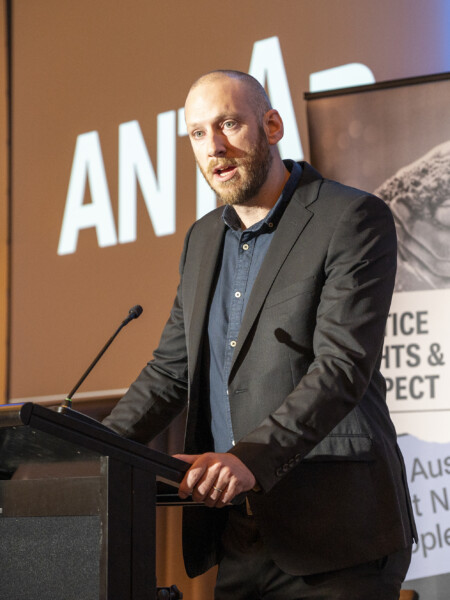I have been asked to provide some legal and constitutional perspectives on the current treaty debate. I do so with some trepidation, aware of the complex philosophical, jurisprudential and political questions which treaties and framework agreements raise. I am also mindful that there is justifiable scepticism, as well as considerable differences within Indigenous communities as to the desirability of treaty-making in contemporary Australia.
My purpose this evening is not to advocate any particular processes or outcomes, rather to provide some information on the historical constitutional and legal background in Australia, comparative developments in other first world countries and at the UN, and options which have been canvassed for treaties in contemporary Australia.
Historical background
Whilst recent months have seen renewed calls for a treaty or framework agreement with Indigenous Australians, the idea is not new. For example, in 1841 in R v Bonjon, Justice Willis reasoned that Aborigines remained ‘unconquered and free, but dependent tribes.’ Their rights ‘as distinct people’ had not been ‘tacitly surrendered.’ As they were ‘by no means devoid of legal capacity’ and had ‘laws and usages of their own’, ‘treaties’ should be made with them. The views of Justice Willis caused consternation in colonial legal and political circles and did not prevail.
However, Justice Willis had raised issues to which Australian courts would one day return. In 1992 in Mabo (No 2) the High Court recognised a concept of native title founded in the traditional laws and customs of Australia’s Indigenous peoples. The High Court’s recognition that Australia was inhabited by peoples with pre-existing rights challenged two hundred years of Eurocentric constitutional, legal and political history. Notwithstanding that the High Court has rejected Indigenous assertions of sovereignty as non-justiciable, it is not surprising that in the aftermath of Mabo Indigenous calls for a negotiated settlement have multiplied.
Comparative experiences
Since the early 1970s Indigenous Australians have been active in the international movement of Indigenous peoples. This has led to greater awareness of ‘modern treaties’ or contemporary agreements which have been negotiated between other Indigenous peoples and States, and the ways in which these have been afforded constitutional and/or juridical protection.
In Greenland, the Inuit have exercised home-rule since 1978. Since 1979, Greenland has been governed by all-Inuit cabinets. There are Sami Parliaments in Finland, Norway and Sweden. Constitutional reforms in Norway have resulted in recognition of the country as bi-cultural – Norwegian and Sami – and a guarantee to the Sami people of means to maintain their distinct culture. In Aotearoa/New Zealand, the Waitangi Tribunal investigates claims of infringements of Maori rights under the 1830 Treaty of Waitangi. In the United States, European colonial powers and later the United States entered into treaties with Indian nations. US courts have upheld Indigenous sovereignty, and affirmed inherent powers of self-government. In 1994, President Clinton confirmed the commitment of the US Government to respect ‘the rights of self-government due the sovereign tribal governments.’
In Canada, there have been several rounds of treaty negotiations. The first round resulted in the early Indian treaties to 1929. A second round has seen treaties negotiated in areas not covered by historical treaties. Amongst these is the 1998 Nisga’a Treaty which aims to reconcile the Aboriginal rights of the Nisga’a people and the sovereignty of the Crown, and to provide the basis for future dealings between the Nisga’a, the province of British Columbia and Canada. The Nisga’a Treaty addresses land title, public access, roads and rights of way, forest resources, fisheries, environmental assessment and protection, Nisga’a government, dispute resolution and fiscal relations. Whilst federal and provincial laws apply to Nisga’a lands and people, there are also areas of concurrent jurisdiction. A third round of treaty negotiations in Canada has produced a series of Northern agreements, including the 1993 Nunavut Final Agreement which created a new Indigenous territory in Northern Canada.
In 1996, the Canadian Royal Commission on Aboriginal Peoples made detailed recommendations in relation to processes for making new treaties, matters for negotiation, treaty institutions and public education about treaties with Indigenous peoples. The Canadian Government recently reported that steady progress is being made in modern treaty negotiations: ‘Settling claims does take time as it is important to get it right… modern treaties provide an important springboard to economic and political growth.’
In 1978, processes of constitutional reform were initiated in Canada. A coalition of Indigenous organisations negotiated amendments which became law in 1982. Constitutional reform has meant that Aboriginal and treaty rights can only be altered or terminated by consent or by constitutional amendment. Section 35(1) of the Constitution Act 1982 provides: “The existing Aboriginal and treaty rights of the Aboriginal peoples of Canada are hereby recognized and affirmed.” Laws contravening s 35(1) can be set aside under s 52(1) of the Constitution Act. Section 35(2) provides that the reference in s 35(1) to ‘treaty rights’ includes rights that now exist by way of land claims agreements or may be so acquired. This provision has provided the basis upon which regional agreements negotiated by Aboriginal peoples in Canada have been invested with constitutional status.
Decisions of the Canadian Supreme Court have provided a firm legal basis for the recognition and protection of Aboriginal and treaty rights. In 1990, in the case of Sparrow v The Queen, the Supreme Court held that section 35 constitutionalises at least part of the rights traditionally associated with the common law of Aboriginal title, including practices that form an integral part of an Aboriginal community’s distinctive culture (in that case, sea fisheries). The 1992 Charlettown Accord would have entrenched in the Canadian Constitution recognition of the ‘inherent right of self-government.’ The Accord was rejected when put to a referendum in October 1992. However, the Canadian Government has stated that the rights protected in section 35 include the ‘inherent right of self-government.’ Aboriginal Self Government; The Government of Canada’s Approach to implementation of the Inherent Right and the Negotiation of Aboriginal Self-Government (Ottawa 1995) provides that:
The Government of Canada’s recognition of the inherent right is based on the view that the Aboriginal peoples of Canada have the right to govern themselves in matters that are internal to their own communities, integral to their unique cultures, identities, traditions, languages and institutions, and with respect to their special relationship to their land and resources.
Developments at the United Nations
As ATSIC Chairperson Geoff Clark noted at Corroboree 2000 on 27 May 2000, such developments in national legal systems have been accompanied by a recognition of the distinct rights of Indigenous peoples in international fora. In UN standard-setting activities, Indigenous representatives have consistently emphasised the significance of treaties and agreements. In 1993, the UN Working Group on Indigenous Populations (WGIP) adopted a Draft Declaration on the Rights of Indigenous Peoples. Article 36 of the WGIP’s Draft Declaration provides:
Indigenous peoples have the right to the recognition, observance and enforcement of treaties, agreements and other constructive arrangements concluded with States or their successors, according to their original spirit and intent, and to have States honour and respect such treaties, agreements and other constructive arrangements. Conflicts and disputes which cannot otherwise be settled should be submitted to competent international bodies agreed to by all parties concerned.
In 1989, the UN appointed a Special Rapporteur on Treaties, Agreements and other Constructive Arrangements between States and Indigenous Populations. The Special Rapporteur has since described a ‘constructive arrangement’ as ‘any legal text and other document which are evidence of consensual participation by all parties to a legal or quasi-legal relationship.’ The most important element is ‘proof of the free and informed consent of all parties concerned to the arrangement’.
More recent Australian developments
In recent years within Indigenous Australia there has been vigorous discussion of the need for constitutional, political and legal settlement between Indigenous and non-indigenous
peoples. Significant events have included:
- The establishment of a tent embassy outside Federal Parliament House in Canberra in January 1972, demanding land rights, compensation and recognition of Indigenous sovereignty;
- The 1979 proposal by the National Aboriginal Congress (NAC) for a Makarrata or treaty to be negotiated between the Commonwealth and Aboriginal peoples of Australia, and in which sovereign Aboriginal nations are recognised as equal in status as the Commonwealth of Australia;
- Kevin Gilbert’s 1987 draft treaty written in consultation with the Sovereign Aboriginal Coalition (Gilbert, Kevin, 1993, Aboriginal Sovereignty, Justice, the Law and Land. p. 52 and following);
- The 1988 Barunga Statement presented to former Prime Minister Bob Hawke by the Chairpersons of the Northern Territory Land Councils calling on the ‘Commonwealth Parliament to negotiate with us a Treaty or Compact recognising our prior ownership, continued occupation and sovereignty and affirming our human rights and freedoms’.
It was with reference to such calls for a settlement of outstanding historical questions, that in early 1994 the previous Federal Government asked the Council for Aboriginal Reconciliation to consider whether there should be a formal place within the reconciliation process for ‘a document or documents of reconciliation’. Other speakers have provided an update on more current efforts by the Council and ATSIC to promote discussion of treatyrelated matters. These include the establishment by ATSIC of a National Treaty Support Group, a national ‘Think Tank’ to assist the Treaty Support Group.
What sense can we make of treaties in contemporary Australia?
What sense can we make of the concept of treaties in contemporary Australia? At a fundamental level, a treaty is an agreement between two or more parties who seek to define the terms and parameters of their relationships with one another. In principle, there is no reason that a national treaty, or a framework of agreed national standards, would be incompatible with treaties and agreements concluded between Indigenous communities and relevant local, regional, State and Territory partners. Thus, a national document could set standards for local or regional treaties. ATSIC Chairperson Geoff Clarke has expressed his conviction that a national treaty must be put in place before there is any devolution to local or regional treaties. The concern is to avoid uncoordinated negotiation, producing unequal and uneven results, and uncoordinated demands.
But why a treaty or treaties in Australia?
There may be legal reasons. In the developing law of native title, the courts have encouraged the resolution of Aboriginal issues by negotiation rather than more costly, adversarial and ill-suited processes of litigation.
There may be social reasons. The social conditions of Indigenous communities in Australia remain dramatically behind that of the Australian population in general. Recognition and the transfer of responsibility and control to Indigenous communities through negotiations can be an essential step towards positive change.
And there may well be economic reasons. Outstanding native title issues and other unfinished business create uncertainty in relation to the use and management of land and resources. A goal of treaty negotiations can be to establish certainty over lands and resources to provide a more secure climate for investment and economic development.
Thus, treaty processes can facilitate:
- Recognition, including legal and Constitutional recognition, of the status of Aboriginal and Torres Strait Islander peoples as the first peoples of Australia, and of the distinct rights and aspirations which flow from such status;
- A framework of agreed national standards to assist the development of local or regional treaties and agreements;
- More constructive and equitable relationships between Indigenous people and Australian governments;
- The development of self-governing institutions, and achievement of greater economic independence and social well-being in Indigenous communities.
Substantive matters for negotiation might include Constitutional recognition, self-determination, including self-government, regional or local agreements, political representation, comprehensive land claims settlement processes, recognition of customary law, heritage protection, cultural and intellectual property rights, and economic development.
However, it is clear that the a priori enumeration of a list of substantive matters for negotiation is doomed to failure.
The preferred approach must be to promote informed discussion of the many challenging issues surrounding treaty-making.
Such discussion must take place amongst Indigenous Australians and between Indigenous and non-Indigenous Australians. Key focus areas will cover processes for determining parties mandated to negotiate and enter into a treaty or treaties, negotiation processes, matters for negotiations, procedures for arriving at agreement, and mechanisms for implementation.
In relation to constitutional recognition, we need to be sceptical about the feasibility of developing a detailed treaty for inclusion in the Constitution. Instead, it might be more constructive to think about a two-pronged approach which seeks:
- To secure protection for those Indigenous rights which have been recognised, as well as those which are recognised in the future;
- To build in some mechanism to ensure that there is informed and far-reaching debate of Indigenous rights, that any agreements which are negotiated are secured constitutionally.
In this regard, the following options for constitutional reform merit debate:
- Remove any remaining provisions which discriminate against people on the ground of race; in particular section 25, which anticipates the disqualification of persons of a particular race from voting.
- Insert in the Preamble paragraphs recognising Aboriginal and Torres Strait Islander peoples as unique peoples with distinct identities and histories, as well as their prior occupation and ownership, continuing dispossession, and particular status in contemporary Australia.
- Secure protection of Indigenous rights which are now recognised (such as native title rights), as well as rights which might be negotiated and recognised in the future (through treaties, agreements and decisions of the High Court amplifying Mabo No 2 etc).
- Insert in the Constitution a commitment to constitutional conferences or other processes to discuss Indigenous rights. A provision similar to section 105(A) might be inserted to vest in the Commonwealth power to make an agreement/agreements with the Indigenous peoples of Australia on a range of subjects. Such a provision might provide, like section 105(A), for the agreement/agreements to override other laws. This approach would obviate the need to put to referendum an extensive catalogue of rights or detailed arrangements and formula and provide, at the same time, a source of Constitutional authority for such an agreement/agreements.
- Such a constitutional conference/s might include an agenda item on mechanisms to secure greater participation of Indigenous peoples in the structures of government and to recognise Indigenous structures of governance. Possibilities include the dedication of Indigenous seats in Parliament, based on an Indigenous electoral roll. Other proposals have referred to constitutional recognition of the right of self-determination including the right of self-government in principle, or in relation to specific regions.
- Affirm the central role of the Federal Government in relation to Indigenous rights; in particular, delete the race power in section 51(xxvi) and possibly replace it with an express Commonwealth power to make laws for the benefit of Aboriginal and Torres Strait Islander peoples.
- Insert in the Constitution a general guarantee of equality and freedom from discrimination.
Conclusions
With renewed calls for a negotiated agreement or treaty, we are asked to grapple with complex issues which are the subject of serious debate and movement in the international arena. It is not just in Australia that Indigenous peoples are calling for new constitutional and legal relationships within the limits of existing nation-States. In many countries Indigenous peoples are (re)establishing new constitutional and legal relationships within the limits of existing nation-States. These developments show that there are many ways to accommodate different peoples and resolve long-standing grievances.
Whilst there is much comparative experience to draw upon, there is no simple or uniform template. If one conclusion can be drawn from comparative experience it is that processes are as important as from and content of any document or documents which may result.
Comparative experience suggests, if anything, the importance of grounding processes in the particular, in geographical realities, in specific historical experiences, in daily lives and priorities.
And in the current discussion in Australia, it will be important to avoid narrow definitions which hinder creative thinking about the potential for negotiated agreements in renewing relations between Indigenous and non-Indigenous Australians, and in enhancing the legitimacy of the Australian polity.
[
Read the complete Treaty Talks given at the ESORA and NAIDOC Week Forums Treaty! Let’s Get It Right!]




